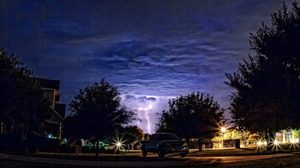
Although lightning strikes can occur at any time during the year, summertime is usually peak season for thunder and lightning storms. Since the inception of Lightning Safety Awareness Week, lightning fatalities in the U.S. have dropped from about 50 per year to an average of 30 or less per year. The NWS attributes this reduction to this weather safety campaign and to a greater awareness of lightning danger, and people seeking safe shelter when thunderstorms threaten.
According to the NWS, as of June 8, there have been five lightning-strike fatalities in the country this year, including a 7-year-old boy from Tennessee. In 2017, there were 16 lightning fatalities in a total of six states, including an 82-year-old man from Brewster, Ohio (Stark County).
There is no safe place outside when thunderstorms are in the area. If you hear thunder, you are likely within striking distance of the storm. Lightning safety is an inconvenience that can save your life. So, “When thunder roars, go indoors!” Stop outdoor activities and seek safe shelter immediately.
The NWS and the Ohio Committee for Severe Weather Awareness encourage Ohioans to prepare for thunder and lightning storms – and all severe weather events.
If thunder and lightning storms are happening in your area, you should do the following:
- Listen to current weather reports on local TV or radio stations, or use a battery-operated NOAA Weather Radio. Be aware of changing weather conditions. Severe thunderstorms can hail, damaging winds and/or tornadoes.
- Avoid contact with corded phones and devices, including those plugged into electrical outlets for recharging. Cordless and wireless phones not connected to wall outlets are safe to use.
- Avoid contact with electrical equipment or cords. If you can do so safely, unplug appliances and other electrical items such as computers, and turn off air conditioners. Power surges from lightning can cause serious damage.
- Avoid contact with plumbing and water. Do not wash your hands, bathe or shower. Do not wash dishes or do laundry. Water and plumbing conduct electricity.
If you’re caught outside:
- Take shelter in a sturdy, substantial building. Avoid isolated sheds or small structures in open areas, such as baseball dugouts.
- Avoid natural lightning rods such as a tall, isolated tree in an open area. Also avoid hilltops or open fields.
- Avoid being in or near bodies of water such as the beach, a swimming pool, fishing, or on a boat.
- Avoid contact with anything metal – tractors, farm equipment, motorcycles, golf carts, golf clubs, and bicycles.
- If driving during a severe thunderstorm, try to safely exit the roadway and park. Stay in the vehicle and turn on the emergency hazard lights until the heavy rain stops. Avoid flooded roadways – Turn Around Don’t Drown®. Just 12 inches of moving water can sweep away most vehicles.
To minimize the risk of being struck by lightning, just remember “When Thunder Roars, Go Indoors!” and stay indoors until at least 30 minutes after the last rumble of thunder or crack of lightning.
For additional information on lightning safety, visit the Ohio Committee for Severe Weather Awareness, ReadyOhio, or the NWS site at www.lightningsafety.noaa.gov.



